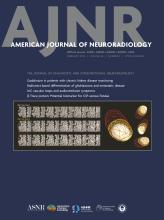This article requires a subscription to view the full text. If you have a subscription you may use the login form below to view the article. Access to this article can also be purchased.
Graphical Abstract
Abstract
SUMMARY: Dextromethorphan toxicity in young children (especially those 4 years of age or younger) can have an extremely poor prognosis if untreated. However, if timely recognized and optimally managed, it can have a good clinical outcome despite a profound initial insult. We present 3 pediatric cases (younger than 5 years of age) with sudden unresponsiveness following ingestion of cough medications containing dextromethorphan. All these children showed cytotoxic edema in the cerebellar hemispheres on MR of the brain, with diffusion-restricting foci in the supratentorial white matter in 2 patients. These features resemble the recently described acute opioid toxidrome in children, pediatric opioid use–associated neurotoxicity with cerebellar edema (POUNCE). Hence, we named this entity dextromethorphan-associated neurotoxicity with cerebellar edema (DANCE) to increase the awareness of dextromethorphan toxicity in young children and the need to promptly recognize it to initiate optimal management.
ABBREVIATIONS:
- DANCE
- dextromethorphan-associated neurotoxicity with cerebellar edema
- IgG
- immunoglobulin G
- POUNCE
- pediatric opioid use–associated neurotoxicity with cerebellar edema
- © 2024 by American Journal of Neuroradiology













